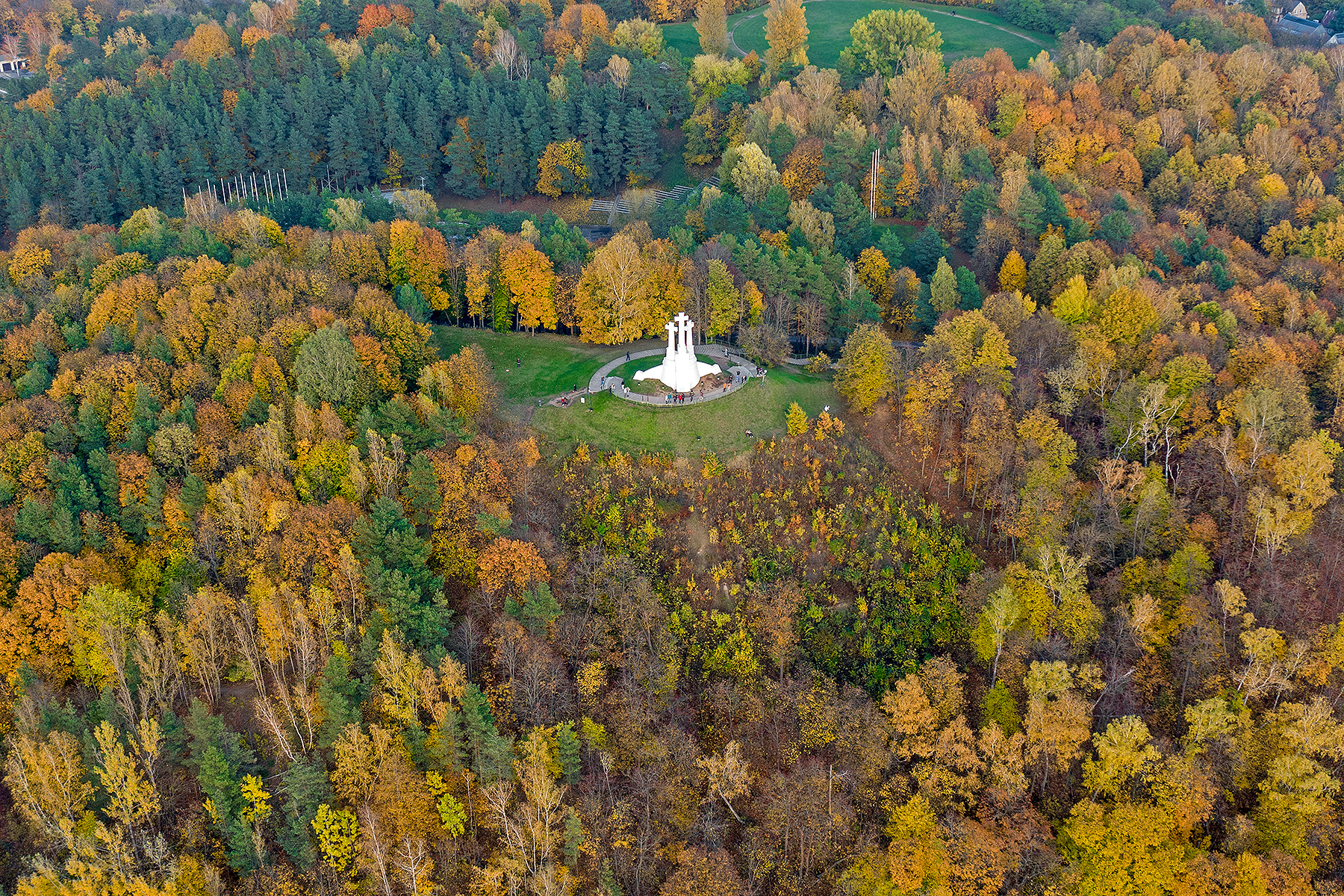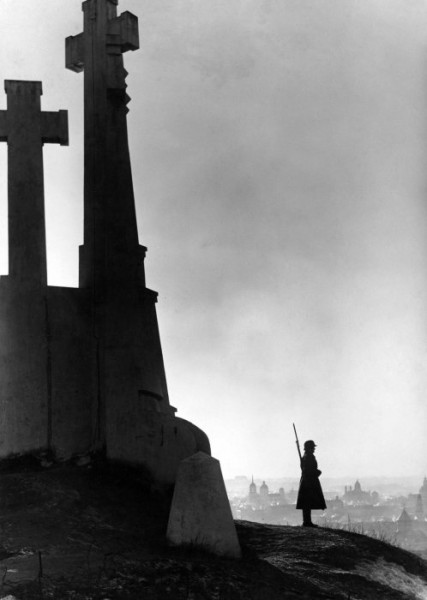Three Crosses on:
[Wikipedia]
[Google]
[Amazon]
 Three Crosses ( lt, Trys kryéƒiai, pl, Gû°ra Trzykrzyska) is a prominent monument in
Three Crosses ( lt, Trys kryéƒiai, pl, Gû°ra Trzykrzyska) is a prominent monument in
 According to the
According to the
 Regardless of whether the legend about the Franciscan martyrs is true or not, their story spread from the early 16th century. The original wooden Three Crosses were built on the Bleak Hill, the place where seven friars were beheaded, sometime before 1649. That is the year when the crosses were depicted in a
Regardless of whether the legend about the Franciscan martyrs is true or not, their story spread from the early 16th century. The original wooden Three Crosses were built on the Bleak Hill, the place where seven friars were beheaded, sometime before 1649. That is the year when the crosses were depicted in a
 Three Crosses ( lt, Trys kryéƒiai, pl, Gû°ra Trzykrzyska) is a prominent monument in
Three Crosses ( lt, Trys kryéƒiai, pl, Gû°ra Trzykrzyska) is a prominent monument in Vilnius
Vilnius ( , ; see also other names) is the capital and largest city of Lithuania, with a population of 592,389 (according to the state register) or 625,107 (according to the municipality of Vilnius). The population of Vilnius's functional urba ...
, Lithuania
Lithuania (; lt, Lietuva ), officially the Republic of Lithuania ( lt, Lietuvos Respublika, links=no ), is a country in the Baltic region of Europe. It is one of three Baltic states and lies on the eastern shore of the Baltic Sea. Lithuania ...
, on the Hill of Three Crosses, originally known as the Bald Hill ( lt, Plikasis kalnas), in Kalnai Park
Kalnai Park ( lt, Kalné° parkas, literally: ''Park of Hills'') is a park between the left bank of the Neris River and right bank of the Vilnia River in Vilnius, Lithuania. It lies within the Vilnius Old Town elderate near Gediminas Hill and G ...
. According to a legend, which finds its source in some historic events, seven Franciscan friars were beheaded on top of this hill. Wooden crosses have been sited in the location since the early 17th century, and they became a symbol of the city and an integral part of the city's skyline.
As the wood rotted, the crosses needed to be periodically replaced. In 1916, a concrete monument was designed by PolishãLithuanian architect and sculptor Antoni Wiwulski or Antanas Vivulskis in Lithuanian. It was torn down in 1950 by order of the Soviet authorities. A new monument designed by Henrikas é ilgalis was erected in its place in 1989. The monument was depicted on 50 litas banknote. A panorama
A panorama (formed from Greek üÃÑö§ "all" + ç
üöÝö¥öÝ "view") is any wide-angle view or representation of a physical space, whether in painting, drawing, photography, film, seismic images, or 3D modeling. The word was originally coined i ...
of the Vilnius Old Town can be observed from a small observation deck at the base of the crosses.
Legend
 According to the
According to the Bychowiec Chronicle The Bychowiec Chronicle (also spelled ''Bykhovets'', ''Bykovets'' or '' Bychovec'') is an anonymous 16th-century chronicle of the Grand Duchy of Lithuania. Although one of the least reliable sources of the epoch, it is considered the most extensive ...
, fourteen Franciscan
, image = FrancescoCoA PioM.svg
, image_size = 200px
, caption = A cross, Christ's arm and Saint Francis's arm, a universal symbol of the Franciscans
, abbreviation = OFM
, predecessor =
, ...
friars were invited to Vilnius
Vilnius ( , ; see also other names) is the capital and largest city of Lithuania, with a population of 592,389 (according to the state register) or 625,107 (according to the municipality of Vilnius). The population of Vilnius's functional urba ...
from Podolia
Podolia or Podilia ( uk, ÅŃÅÇîţţî, Podillia, ; russian: ÅŃÅÇŃţîÅç, Podolye; ro, Podolia; pl, Podole; german: Podolien; be, ÅůÅÇŃţţÅç, Padollie; lt, Podolá), is a historic region in Eastern Europe, located in the west-centra ...
by Petras GoéÀtautas. The friars publicly preached the gospel
The gospel or good news is a theological concept in several religions. In the historical Roman imperial cult and today in Christianity, the gospel is a message about salvation by a divine figure, a savior, who has brought peace or other benefit ...
and badmouthed Lithuanian gods. Angered city residents burned the monastery and killed all fourteen friars. Seven of them were beheaded on the Bleak Hill; the other seven were crucified and thrown into the Neris
The river Neris () or Viliya ( be, ÅîäÅ£îî, pl, Wilia ) rises in northern Belarus. It flows westward, passing through Vilnius (Lithuania's capital) and in the south-centre of that country it flows into the Nemunas (Neman), at Kaunas, a ...
or Vilnia River
The Vilnia (also ''Vilnelá''; , ''Vilnia'' ; ) is a river in Lithuania. Its source is near the village of Vindéƒié¨nai, 5 km south of é umskas, at the Lithuanian-Belarusian border. The Vilnia is 79.6 km long and its basin covers 624&nb ...
. Historians debate the factual accuracy of the story. It could be an embellishment of a story from '' Chronica XXIV Generalium'' about two Franciscans murdered around 1340. It could also be an embellishment of a story from ''De Conformitate Vitae B. P. Francisco'' by Bartholomew Rinonico about five Franciscans martyrs. If the latter is the case, the event most likely occurred in 1369.
History
 Regardless of whether the legend about the Franciscan martyrs is true or not, their story spread from the early 16th century. The original wooden Three Crosses were built on the Bleak Hill, the place where seven friars were beheaded, sometime before 1649. That is the year when the crosses were depicted in a
Regardless of whether the legend about the Franciscan martyrs is true or not, their story spread from the early 16th century. The original wooden Three Crosses were built on the Bleak Hill, the place where seven friars were beheaded, sometime before 1649. That is the year when the crosses were depicted in a panegyric
A panegyric ( or ) is a formal public speech or written verse, delivered in high praise of a person or thing. The original panegyrics were speeches delivered at public events in ancient Athens.
Etymology
The word originated as a compound of gr ...
to Bishop Jerzy Tyszkiewicz
Jerzy Tyszkiewicz ( lt, Jurgis TiéÀkeviáius; 1596ã1656) was auxiliary bishop of Vilnius from 1627 to 1633, bishop of Samogitia from 1633 to 1649, and bishop of Vilnius from 1649 to 1656.
Biography
He was born in Vistyáy ( be, Åîîîîîî ...
. Around the same time Tyszkiewicz began a case to canonize the fourteen friars. There is some evidence that the crosses were built before 1636 as, according to Jan Nepomucen Fijaéek, the crosses were also depicted on two silver portraits of St. Casimir that were made in 1636 and hung in Vilnius Cathedral
The Cathedral Basilica of St Stanislaus and St Ladislaus of Vilnius ( lt, Vilniaus é v. Stanislovo ir é v. Vladislovo arkikatedra bazilika; pl, Bazylika archikatedralna éw. Staniséawa Biskupa i éw. Wéadyséawa, historical: ''Koéciû°é Kated ...
. However, the portraits did not survive and Fijaéek's claim cannot be verified.
The wooden crosses collapsed in 1869 and Tsarist authorities did not allow to rebuild them. The new monument from reinforced concrete designed by Antoni Wiwulski was erected in August 1916, while Vilnius was occupied by the Germans during World War I
World War I (28 July 1914 11 November 1918), often abbreviated as WWI, was List of wars and anthropogenic disasters by death toll, one of the deadliest global conflicts in history. Belligerents included much of Europe, the Russian Empire, ...
. The monument was demolished by Soviet authorities on May 30, 1950. Residents of Vilnius wanted them restored. During the Lithuanian independence movement, the monument was rebuilt on the old foundations according to the project of sculptor Henrikas é ilgalis. The monument was unveiled on 14 June 1989. The rebuilt crosses now are higher than those of 1916. Broken pieces of the old monument can be seen several meters below the rebuilt monument.
See also
*Hill of Crosses
Hill of Crosses (Lithuanian: ) is a site of pilgrimage about 12 km north of the city of é iauliai, in northern Lithuania. The precise origin of the practice of leaving crosses on the hill is uncertain, but it is believed that the first crosse ...
* ''''
References
{{Coord, 54.6867, N, 25.2976, E, region:LT_type:landmark, display=title Landmarks in Vilnius Monuments and memorials in Lithuania Cultural infrastructure completed in 1916 Mountain monuments and memorials Hills of Lithuania Tourist attractions in Vilnius